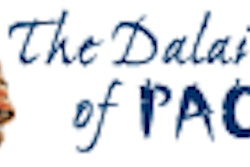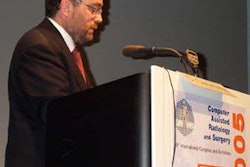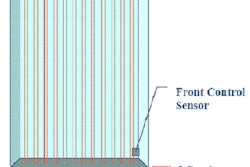Despite the potential of lossy compression to speed image transmission and ease image storage requirements, negative perceptions have largely limited its use in PACS environments. But those concerns may no longer be appropriate, according to a literature review and a legal risk assessment of the technology from Canada Health Infoway.
"Based on the (Infoway) literature review as well as the legal risk assessment, the Canadian Association of Radiologists has endorsed the use of lossy compression for primary reading," said Peter Bak, project director of diagnostic imaging architecture for Canada Health Infoway, a nonprofit corporation tasked with developing the architecture for Canada's electronic health record (EHR) initiative.
Bak spoke during a presentation in June at the Society for Computer Applications in Radiology (SCAR) annual meeting in Orlando, FL.
As part of an evaluation of the use of lossy compression, Canada Health Infoway commissioned two independent reviews of the literature to assess the degree of research conducted to evaluate irreversible compression, and also performed a legal risk assessment of the technology.
It's a fact that relevant information is lost in lossy compression, leading to the perception that a misdiagnosis is possible due to the missing information, Bak said. There's a concern that radiologists and administrators have increased legal risk, which has led to little or no adoption of lossy compression, he said.
If feasible, however, lossy compression would offer considerable value in Canada, which has begun deploying a pan-Canadian interoperable EHR. As part of that initiative, Canada is moving aggressively toward a fully filmless medical imaging environment.
"We hope to print hopefully no film, but certainly not much more than 2% of our exams," Bak said.
The nation performs about 35 million exams a year, with estimated current annual storage volume of approximately 3 petabytes. An aging population is expected to increase exam volume and CT utilization, and Canadian healthcare facilities are widely dispersed across a large area, he said.
Networking is also a big challenge. There are more than 540 facilities with fewer than 100 beds in rural Canada, and most of these sites have limited network connectivity, Bak said. Canadian radiologists and specialists are also centered in the larger metropolitan areas, producing a challenge in getting images from rural facilities to metropolitan centers in a timely fashion, he added.
"We see lossy compression as having a very considerable positive impact on our EHR," Bak said.
To challenge the status quo, the study sought to question whether perceptions about lossy compression are valid, and if they're not, determine how to drive acceptance and adoption of the technology.
As part of a multifocal study of the technology and adoption barriers, Infoway commissioned two independent literature reviews, which involved a scan of radiology and technical journals to assess the degree of research evaluating lossy compression. They also sought to determine if there was a consensus of opinion among those who have evaluated the effects of irreversible compression on diagnostic image quality.
The analysts reviewed more than 120 papers, predominantly looking at those from 1998 to present. There were two predominant compression algorithms with multiple schemes: discrete cosine transform (DCT), which included JPEG and JPEG-LS; and wavelet-based compression, which included JPEG2000 and other schemes.
The analysts found research to be fragmented, with most of the evaluations focused on the application of a specific compression scheme to a specific modality and anatomy. Modalities have different compression tolerance, and therefore a single compression ratio can't be assigned to a modality, Bak noted.
Also, anatomy was found to influence compression tolerance, although to a lesser degree than the modality, he said.
From their review, the researchers concluded that lossy compression was a clinically acceptable option for medical image compression, and that in comparison to wavelet, JPEG is an inferior algorithm that exhibits poorer ratios, peak signal-to-noise ratio (PSNR) values, artifacts, and flexibility, Bak said.
The reviewers also concluded that large-matrix images can be compressed at up to 50:1 for wavelet, with 25:1 seeming to be an optimum ratio, he said. Small-matrix images were judged to be compressible up to 20:1, with 10:1 appearing to be an optimum ratio.
"The extent of allowable lossy compression ratio is dependent on the modality, as well as the nature of the imaged pathology and anatomy," Bak said. "JPEG2000 performed as well as most other wavelet schemes, but with the added benefit of being an ISO (and potentially DICOM) standard."
Legal risk?
In another Infoway-related talk at SCAR, consultant Paul Brownrigg presented research on the legal risk associated with using lossy compression. Performed to assess the legal risk to Fraser Health Authority (FHA) in British Columbia and its physicians, the review sought to offer recommended approaches to adoption as well.
"(We also wanted) to help radiologists answer this question, 'By definition, a lossy compressed image has loss information, and therefore I might miss a finding and get sued,'" said Brownrigg, president of Insite Consultancy.
A regulatory and legal liability risk assessment was produced from two qualified legal opinions. With compression, regulators rely on the professions to lead the way; there are no regulations governing the use of lossy compression in Canada, the U.K., Australia, or the U.S., Brownrigg said.
"The FDA doesn't actually regulate use (of technology), just the entry of products into the U.S. market," he said.
In Canada, however, the Canadian Association of Radiologists has endorsed the use of lossy compression for primary reading.
As for legal liability risk assessment of lossy compression, it's almost exclusively a virtue of the tort of negligence, Brownrigg said. Tort of negligence deals with virtually every sort of accident, ranging from icy sidewalks to medical mishaps.
Tort is important in three aspects: balancing interests, fact sensitivity, and uncertainty, Brownrigg said. Tort manages competing interests by balancing the desire to compensate patients who suffer avoidable injuries, the need for healthcare professionals to rely on the best information available, and the community's interest in having a medical system that responds quickly and efficiently to pressing needs, he said.
As it involves a delicate balancing of competing interests, the tort of negligence is highly fact-sensitive, he said. A small difference in circumstance may have a substantial impact on liability.
"It is important to be well-informed when adopting any new technology," Brownrigg said.
The flexibility and sensitivity of the tort in negligence creates uncertainty, and lossy compressed medical images have not yet been addressed by the courts.
Factors affecting liability include duty of care, standard of care, and vicarious liability, Brownrigg said. Under vicarious liability, employers are liable for any negligence when the employee is acting within the scope of the department. Health authorities will not generally be liable for the negligence of physicians, however, unless they are employees, he said.
As for physician liability, a patient plaintiff must prove that the physician owed a duty of care, that the physician did not take adequate care, and that the failure to take adequate care was the cause of the damage of the patient's complaint, he said.
"The use of lossy compression does not present any greater risk to the FHA or physicians then the typical risks that we live with in normal circumstances," Brownrigg said.
The reviewers reached that conclusion, provided that appropriate ratios are used, there is no clinically significant loss of data, and lossy compression is used in primary reading (avoid altering records after primary reading), he said.
Also, the technology should not be adopted recklessly, Brownrigg said. Due diligence -- such as literature reviews, education, supervision, and of course, ensuring appropriate use of the technology -- should be applied.
The reviewers recommended that users refer to the literature to obtain "best and current information," and that they understand the concept behind JPEG2000 lossy compression, he said. They also recommended that users follow and refer to existing work and recommendations on the subject, and that they select appropriate compressions per modality with reference to the literature.
"Produce a professional endorsement statement that covers all of the above," he said.
In addition, users should ask their health board to produce a formal policy on lossy compression citing the professional opinion and the health economic benefits, Brownrigg said. Clinician users should also be educated in lossy compression, and training grades should be supervised as usual, he said.
By Erik L. Ridley
AuntMinnie.com staff writer
July 21, 2005
Related Reading
Foresight aids PACS migration, June 4, 2005
PDAs show promise for RIS/PACS portability, May 13, 2005
3D JPEG 2000 compression shines in multislice CT data, February 9, 2005
Web-based application nets teleradiology benefits, January 31, 2005
Copyright © 2005 AuntMinnie.com




















